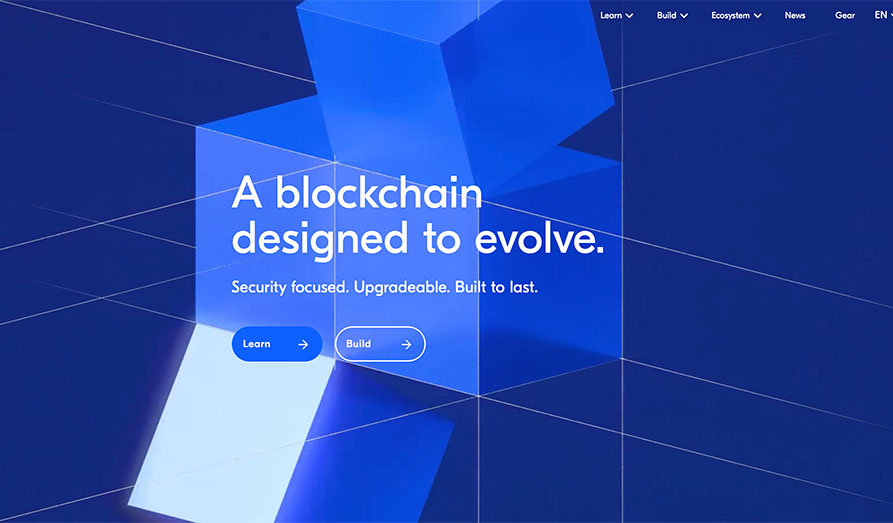
As the first Blockchain to introduce the self-amending protocol, Tezos has impacted the crypto domain. The decentralised open-source Blockchain can execute peer to peer transactions as a base for smart contracts. The platform ensures active community participation and governance. These mechanisms mean you can propose, evaluate, and approve amendments to the Blockchain. Its proof-of-stake algorithm is energy efficient, unlike proof of work platforms like Ethereum or Bitcoin and requires significantly less cost of operation.
Briefly about Tezos Network
The blockchain was proposed initially by Arthur Breitman under the L. M. Goodman pseudonym in 2014. It was conceived as a self-amending platform-built protocol of on-chain governance. Its smart contract platform empowers decentralised applications, called DApps, to compete with similar platforms. Breitman and his wife, Kathleen, oversaw the platform core development using their Dynamic Ledge Solutions. After a spearheading and high-profile initial coin offering in 2017, raising over $232 million, the project faced legal battles over control of the foundation.
Tezos is security focused, upgradeable and built to last. CryptoLists.com
It is a Blockchain network linked to the Tez digital token. The platform isn’t based on mining the coins, but you get rewarded for participating in the proof of stake or PoS consensus as a coin holder. Via its native XTZ cryptocurrency, the self-amending Blockchain uses Ethereum-like smart contracts as a decentralised ledger. According to its developers, Tezos is ancient Greek for smart contracts. However, the Blockchain goes beyond previous offerings by letting the participants control the network rules directly. It’s an evolving network, one devoid of the scalability, inflexibility and growing pains experienced by Bitcoin.
Utility of Tezos Network?
Holders of the blockchain token, XTZ, develop, vote and implement changes to the platform without causing hard crypto forks. Forking is the idea that a crypto currency could upgrade itself to create two separate coins with different prices. The platform on-chain governance principles contrast the often cumbersome, off-chain processes prevalent Ethereum and Bitcoin employ.
In 2018, XTZ launched, allowing holders to stake or bake their coins in the PoS consensus process directly or through delegating voting powers. With its liquid proof of stake or PLoS, the blockchain makes delegation an optional utility. That’s to maintain dynamic validator sets while facilitating token holder accountability, governance and coordination.
Tezos Network
Tezos Network Consensus Method: Proof of Stake
Release Date: June 28, 2018
Advantages at Tezos Network
 + One of the biggest competitors in the PoS space
+ One of the biggest competitors in the PoS space+ A smart contract, DApp platform with earnings of 5.53% APY.
+ Upgrades happen regularly and whenever the community deems necessary.
+ Tezos blockchain is 40x faster than Bitcoin or Ethereum.
Disadvantages
- If bullish or bearish trends occur, Tezos may see heavy volatility.
- The Tezos community is not nearly as huge as Ethereum or Bitcoin.
- Between 23 and 37 days waiting before receiving your reward payments.
Costs
▪ Rated at 9/10Bakers in Tezos bake new blocks, just like Bitcoin miners do. To bake on this Blockchains network, you have to deposit a bond of 8.25% of your total number of tokens. Once blocks are formed, 32 random bakers become delegates to endorse by verifying and witnessing its authenticity.
After endorsing, bakers receive rewards and associated transaction fees. As such, a baker will select the transaction with higher fees, but malpractice is punished with confiscation of their security deposit.
Reputation and Buzz
▪ Reputation rated at 9/10▪ Buzz rated at 9/10
The platform has gained 10% recently after it was reported having struck a multi sponsorship deal with the wealthiest soccer team in Europe, Manchester United. Under the $27 million per year contract, their logo appeared on the clubs training uniform and promised new experiences on their Blockchain.
The cryptocurrency had earlier partnered with video game maker Ubisoft and launched Ubisoft Quartz. Depending on in-game terms, users obtain non-fungible tokens or NFTs. The platform is ranked at 40 in terms of market capitalisation for crypto, approaching $4 billion.
Given these recent gains, the pipeline wonders if the platform will follow partnerships or return to volatility. Others forecast that XTZ will chart at all-time highs with overall market surges. But with Russia threatening to ban mining and crypto trades, and the Federal Reserve mulling over interest rate hikes, it may turn out volatile again.
FAQ
What are smart contracts?
Smart contracts are self-regulating agreements running autonomously from the platform. To fulfil contractual obligations, each part of a smart contract specific conditions to be met before action can be made. The platform is permission-less and is the backbone of all of the protocol’s DApps.
How do you stake on Tezos Blockchain?
There are no mining requirements on the platform, seeing as the platform runs under the Delegated Proof of Stake or DPoS protocol. Instead, the model implements the baking and delegation of tokens, where bakers act as miners and validators. A baker then earns incentives for their labour, which they’ll share proportional to the amount you’ve locked in a smart contract.
Where do I stake on Tezos XTZ?
Wallets like Binance, Atomic Wallet, Ledger Wallet and Coinbase will offer access to staking on Tezos. These, among others, will offer different Returns on Investment or ROI and transaction fees. The platforms native wallet is Trust Wallet for XTZ purchases, swaps, sending, receiving and monitoring your portfolio.
What is a Blockchain fork?
A Blockchain fork happens when the chain diverges into two potential paths. There can be a soft fork or a hard fork.





























